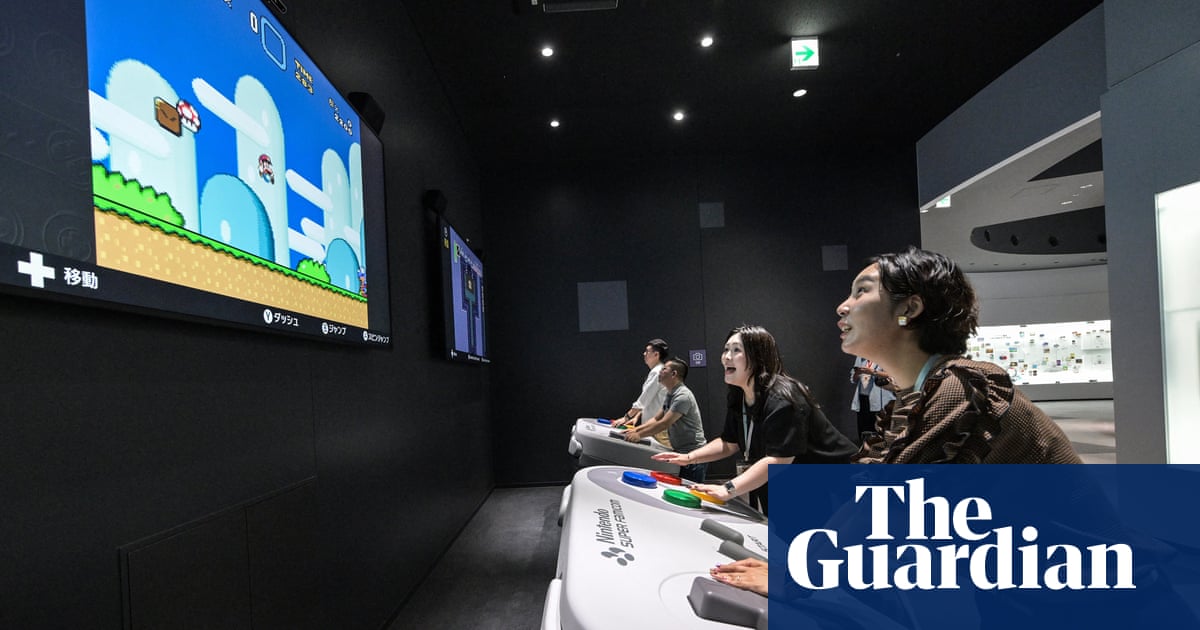Traditionally, visitors to Kyoto in October come for momijigari, the turning of the autumn leaves in the city’s picturesque parks. This autumn, however, there is a new draw: a Nintendo museum.
The new attraction, which opens on Wednesday, is best described as a chapel of video game nostalgia. Upstairs, Nintendo’s many video game consoles, from 1983’s Famicom through 1996’s Nintendo 64 to 2017’s Switch, are displayed reverently alongside their most famous games. On the back wall, visitors can also peer at toys, playing cards and other artefacts from the Japanese company’s pre-video-game history, stretching back to its founding as a hanafuda playing card manufacturer in 1889. Downstairs, there are interactive exhibits with comically gigantic controllers and floor-projected playing cards.
Situated on the site of the video game company’s old manufacturing plant in Uji, a 20-minute train ride south of central Kyoto, the museum is expected to welcome up to 2,000 people a day. Tickets – which are allocated via a lottery system and cost 3,300 yen (£17) for an adult – are sold out three months in advance. When it opened in 1969, Nintendo’s Uji Ogura plant manufactured the toys and playing cards that were Nintendo’s money-makers at the time. After the dawn of the video game age in the 1970s, it operated as a customer service centre for console repairs until 2016. The building is far from Kyoto’s other tourist attractions: the suburban town surrounding it has been renovating its train station, preparing for a flood of visitors in Mario hats.
Nintendo’s creative guru, Shigeru Miyamoto, the creator of the Mario and Zelda series and an evident influence on the museum’s curation, used to visit this site often when it was still a working factory in the 1970s and 80s. “This a place of memories,” he said at a press conference during a preview event at the museum last week. “We were exploring how to preserve it somehow, and then the suggestion came up: why not make it into a museum? Our original headquarters in Toba-kaido was one of the candidates [for a museum site], but we decided that [Uji] would be convenient for transportation, and this area is now rather dilapidated. Since this is where we had our first factory, we wanted to help revitalise the area … We would like to work with the local community to develop [the museum] so that it isn’t resented by the local people.”
Visitors are given 10 virtual coins per visit, used to spend on the interactive exhibits. An adjacent hanafuda workshop guides guests through making their own Japanese playing cards, above a cafe that serves custom burgers. Given Nintendo’s notorious secrecy about its creative process – and corporate secrets – it is perhaps unsurprising that there is no insight into how any of the games or consoles on display were made, or who played a part in their development. Only a small display of factory prototype controllers give the briefest peek behind the curtain.
This museum is part of a growing number of video game tourist destinations in Japan. For decades, international video game fans have made the pilgrimage of the “geek mecca” of Akihabara in Tokyo, with its overstuffed electronics shops, once-great arcades, retro game shops, tucked-away arcade cabinet specialists and plethora of manga and anime-themed cafes. But now there is also the Super Nintendo World theme park at Osaka’s Universal Studios, the third-most-visited theme park in the world, and restaurants in every major Japanese city themed around famous games such as Kirby, Monster Hunter and Final Fantasy. A Pokémon theme park is also in the works in Inagi, Tokyo.
“Companies like Nintendo are hugely important for Japan’s cultural exports,” said Bloomberg’s Japan columnist, Gearoid Reidy. “These cultural exports and tourism form a symbiotic relationship – tourists come to Japan, perhaps in part because they’re interested in, say, Nintendo. Over time, they absorb new trends they encounter and bring them back home – think the rise of ramen over the past few decades.
after newsletter promotion
“Firms like Sega or Sanrio, or properties like Jujutsu Kaisen or Elden Ring, are what is really boosting fondness for the country right now. They’re one of the key drivers behind the surge in people coming to the country, which has risen sevenfold in just 20 years.”
The Japanese government’s new Cool Japan strategy, announced in June, aims to quadruple the overseas market for video games, manga, anime and other cultural exports in the next decade. But for Nintendo, this museum is about preserving to its own corporate heritage. “I hope people will understand what Nintendo is through all of these past products,” said Miyamoto. “It would be a shame to have all of this gathering dust in a warehouse.”

